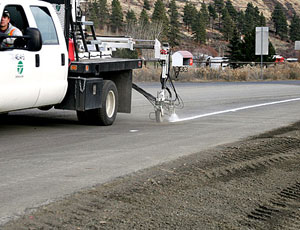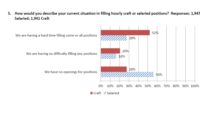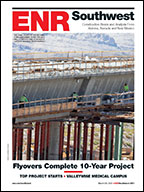Already scrambling for highway funding, state departments of transportation and road contractors now are stymied by a nationwide shortage of pavement-marking paint.

The source of the shortfall is a mixture of economics, chemistry, production disruptions and international trade, and the result will likely be rationed paint and higher prices through most of the summer—and perhaps beyond.
Brian Deery, senior director of the Highway & Transportation Division at the Associated General Contractors of America, says DOTs may have to resort to other measures to conserve their paint stocks, including forgoing painting mainline road edges and ramps, narrowing the width of certain striping, or relying more on temporary tape.
“None of them are good options,” he says, adding that the shortage is potentially even more critical for highway contractors that have contracted price and schedule obligations.
The root of the deficiency is the limited availability of methyl methacrylate (MMA), an ingredient in acrylic-based highway paint, which is the pavement marking material of choice among DOTs because of its brightness and durability.
Two years of a recession-driven downturn put MMA in short supply, forcing companies to switch to other products or discontinue production entirely, according to Phil Phillips, managing director of CHEMARK Consulting Group Inc., Southern Pines, N.C., which focuses on coatings and specialty chemicals.
Because of both scheduled and unexpected manufacturing outages, the remaining producers weren’t ready for a surge in demand for MMA this spring.
“They were caught unprepared, no question about it,” Phillips says, noting that the generally slow rollout of stimulus-funded projects in 2009 had been covered by existing MMA production capacity.
The other chemical culprit is titanium dioxide (TiO2), which gives white pigments their brightness and high reflectivity. Until a few weeks ago, Phillips says, most paint manufacturers were importing TiO2 from China at relatively low cost. However, rising internal demand led China’s government to discontinue international sales of TiO2, he reports.
“The result is a one-two punch that has hit both producers and buyers of acrylic paint,” Phillips says.
While Phillips expects TiO2 supplies to gradually increase over the coming months as domestic suppliers ramp up production, restoring the flow of MMA appears more problematic.
Strong Demand, Unplanned Outages
“It’s an industry-wide issue due to a combination of strong demand, and planned and unplanned outages across many industry producers globally,” says Rebecca Bentley, Dow Chemical spokesperson.
Bentley cited an April report from a news service that covers the chemical industry, that a five-week planned overhaul at coating supplier Lucite International’s 175,000 metric ton/year MMA plant in Memphis, Tenn., left the company with insufficient inventory to meet sales obligations.
Dow’s MMA manufacturing unit in Deer Park, Texas, also experienced production issues that resulted in several...




Post a comment to this article
Report Abusive Comment